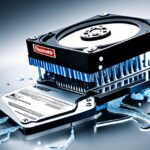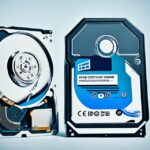Table of Contents
In today’s world, we need huge storage devices more than ever. They help keep loads of data safe and make sure programs run well. This makes our computers work better. Storage has changed a lot over time, moving from old-school hard drives to new solid-state ones. These changes offer many choices for storing our ever-growing data piles. Whether it’s stopping at megabytes or climbing to terabytes, big storage plays a vital role. It changes how we use computers at home and work. This article looks at the big world of storage, exploring different types and their jobs. We’ll see how they’re changing technology for the better1.
Key Takeaways
- Large capacity storage devices are essential for effective data management.
- The evolution from HDDs to SSDs reflects significant technology advancements.
- Storage capacities are critical for retaining increasingly large volumes of data.
- Combining HDDs and SSDs optimises computer performance and functionality.
- Implementing robust backup strategies is vital to protect stored data.
Understanding Storage Devices
A storage device handles storing and retrieving digital data in computers. These devices let users create, change, and keep files needed for different tasks. They come in types like hard disk drives (HDDs), solid-state drives (SSDs), and external storage options.
Definition of a Storage Device
The term storage device definition covers a variety of hardware. Each kind is made for efficient data management. HDDs have large storage capacities, using magnetic technology to keep data. SSDs work faster and come in sizes up to multiple terabytes. They are pricier than HDDs2.
The Role of Storage in Computer Functionality
Storage devices do more than just hold data; they support computers’ overall operations. Primary storage like RAM helps with immediate tasks. Secondary storage, such as HDDs and SSDs, keeps data long-term. This is vital for computers to work well. For instance, motherboards can use two SATA hard disk drives in a RAID setup. This setup improves data security and integrity3.
Types of Storage Devices
In today’s digital era, knowing about different storage devices helps us manage data well. We can sort them by how they work and their technology. Main types include Hard Disk Drives (HDD), Solid-State Drives (SSD), and external or network storage options.
Hard Disk Drives (HDD)
Hard Disk Drives are key in storing data. They use mechanical platters and magnets to save information, offering lots of storage for less money. Around 70% of computers use HDDs for their main storage. This makes them the most common storage device in both personal and business computers today4.
Solid-State Drives (SSD)
Solid-State Drives use NAND flash memory for quicker data access and are more reliable, as they don’t have moving parts. Their speed and dependability have boosted their popularity. Now, SSDs, along with devices like pen drives, make up 60% of the market for secondary storage4.
External and Network Storage Solutions
USB drives and portable HDDs offer easy ways to transfer and backup data. Network storage, like NAS, lets multiple devices access files centrally, making data management better. Virtual storage’s use is growing, with 40% of people and companies storing their data remotely5.
Why Large Capacity Storage Devices Matter
Today, we’re creating more digital data than ever before. It’s vital we have large storage to keep up. Big storage devices help us manage growing data needs without using too many resources.
Expanding Data Management Capabilities
With large storage, we can organise huge amounts of data easily. Hard disks now come with terabytes of space. They store lots of photos, music, and videos6.
This means businesses and people can keep working smoothly. They don’t have to worry about running out of space.
Facilitating Efficient Backups and Transfers
Big storage devices make backing up and transferring data easy. This keeps our data safe and sound. With NAS devices, we can meet our growing data storage needs7.
Large Capacity Storage Device Inside Computer
Adding big storage devices to a computer is key for better performance and keeping data safe for a long time. The growth of HDDs and SSDs lets users enjoy fast speeds and manage data well. SSDs, for instance, make computers start and open programs quicker. This makes the computer much more responsive. HDDs are important too but can be slower because they have moving parts.
Enhancing Performance and Speed
Technology advances have made SSDs the top choice for storage, thanks to faster reading and writing of data. The NVMe protocols have made SSDs even quicker, reducing delay and bumping up data flow89.HDDs have also got better, using fast interfaces like SATA or SAS. They were first made by IBM in 1956. Now, they can handle more data and work faster, letting more apps run smoothly.
Long-Term Data Retention Benefits
Using big storage devices means you can keep lots of data without always needing extra backups. SSDs are made to last a lot of write cycles, which is great for keeping data over time. HDDs too are reliable for storing data long-term. This helps keep important work safe. It also helps users manage their data better across different places89.
The Evolution of Storage Technology
The story of how storage technology has evolved is truly amazing. We’ve gone from old magnetic tape systems to today’s super-fast SSDs. Each development shows our goal to store more data efficiently.
Advancements in HDD and SSD Technology
Since the IBM 350 was released in 1956 with just 5 megabytes, HDDs have come a long way. Today, we have drives that can hold terabytes of data, meeting the high demands of the digital age1011. On the other hand, SSDs started with SanDisk’s 20 megabyte drive in 1991. Now, they offer huge capacities and faster access times thanks to breakthroughs like NVMe. This tech cuts down on delay and speeds up data retrieval compared to older storage ways.
Future Trends in Data Storage Solutions
Future data storage looks set to embrace cloud solutions. This means using different kinds of storage for all types of data, from unstructured object storage to structured file storage, and block storage for databases10. New materials like graphene might lead to even better storage devices. These could offer more space and faster speeds11. As we keep looking for new ways to store data, it’s clear that innovation is at the heart of this journey.
Conclusion
In today’s world, we can’t stress enough how crucial storage devices are. They help manage data effectively and boost the performance of various applications. The move towards generating a mammoth 163 zettabytes of data by 2025 highlights the growing need for strong data management solutions12.
Storage technology is getting better all the time, offering ways to streamline how we handle data. Innovations like hybrid cloud solutions and quick data access through NVMe tech are game-changers. It’s critical for users to stay up-to-date with these advances to improve their digital environments and secure efficient data management for the future13.
Many organisations now use tiered storage systems to manage their data better, which reflects the varied demands across different sectors. By choosing the right storage options, businesses can unlock the full potential of their data. This is key in adapting to the ever-changing world of technology and staying ahead of data challenges14.
FAQ
What is a large capacity storage device?
A large capacity storage device stores a lot of digital data. These are things like hard disk drives (HDDs) and solid-state drives (SSDs). They help manage data well and support many applications.
How do HDDs and SSDs differ in terms of performance?
HDDs use mechanical platters for storing data. They usually offer more space for less money. SSDs use NAND flash memory. This makes them faster and more reliable since they don’t have moving parts. This boosts the performance of systems.
Why are large capacity storage solutions essential for businesses?
Large capacity storage is key for businesses. It lets them store lots of data. This improves how organisations work and how easily they can get to their data. They make backing up data and transferring it quick, keeping operations smooth and data safe.
What role does secondary storage play in a computer?
Secondary storage, like HDDs and SSDs, is for keeping data long-term. It’s different from RAM, which is for short-term tasks. Secondary storage saves and retrieves important files and apps for a long time.
How has the evolution of storage technology impacted data management?
The advancements in storage tech have greatly improved HDDs and SSDs. Storage space has grown and speed has increased. This meets the expanding needs for data in both personal and business settings. It makes managing data better.
What are some current trends in large capacity storage devices?
Nowadays, trends in storage include moving towards cloud storage. Also, there are new developments in SSD technology and the use of artificial intelligence. These are aimed at bettering how we manage and retrieve data.
How can I ensure the longevity of my storage device?
To keep your storage devices lasting longer, back up data regularly. Watch the health of your devices. Use your storage smartly and keep them away from too much heat. Choosing high-quality brands and keeping up with new tech can help too.
What is the ajki of external storage solutions?
External storage, like USB flash drives and NAS, is very important. It lets you store files in one place for many devices. This makes managing and sharing data across networks easier.
Source Links
- https://www.lenovo.com/us/en/glossary/storage-device/ – Why do I Need a Storage Device? A Guide to Different Types
- https://www.geeksforgeeks.org/what-is-a-storage-device-definition-types-examples/ – What is a Storage Device? Definition, Types, Examples – GeeksforGeeks
- https://www.explainingcomputers.com/storage.html – ExplainingComputers.com: Storage
- https://unacademy.com/content/nda/study-material/computer/list-of-storage-devices/ – List of Storage Devices
- https://en.wikipedia.org/wiki/Computer_data_storage – Computer data storage
- https://homepage.cs.uri.edu/faculty/wolfe/book/Readings/Reading05.htm – How Computers Work: Disks And Secondary Storage
- https://www.backblaze.com/blog/whats-diff-ram-vs-storage/ – Memory vs. Storage: A Look at What They Are and What They Do
- http://cs.sru.edu/~mullins/cpsc100book/module03_internalHardware/module03-04_internalHardware.html – Internal Hardware: Mass Storage – Disks
- https://www.techtarget.com/searchstorage/definition/storage-medium – What is a storage medium (storage media)?
- https://www.linkedin.com/pulse/evolution-storage-devices-francisco-velázquez-cruz – The Evolution of Storage Devices
- https://www.pcmag.com/news/the-evolution-of-pc-storage-media – From Floppies to Solid State: The Evolution of PC Storage Media
- https://www.techtarget.com/searchstorage/definition/storage – What is computer storage and how is it used?
- https://www.eprovided.com/data-recovery-blog/types-computer-storage/ – Computer storage options
- https://www.recordnations.com/articles/media-history/ – The History of Computer Storage Devices | Record Nations












